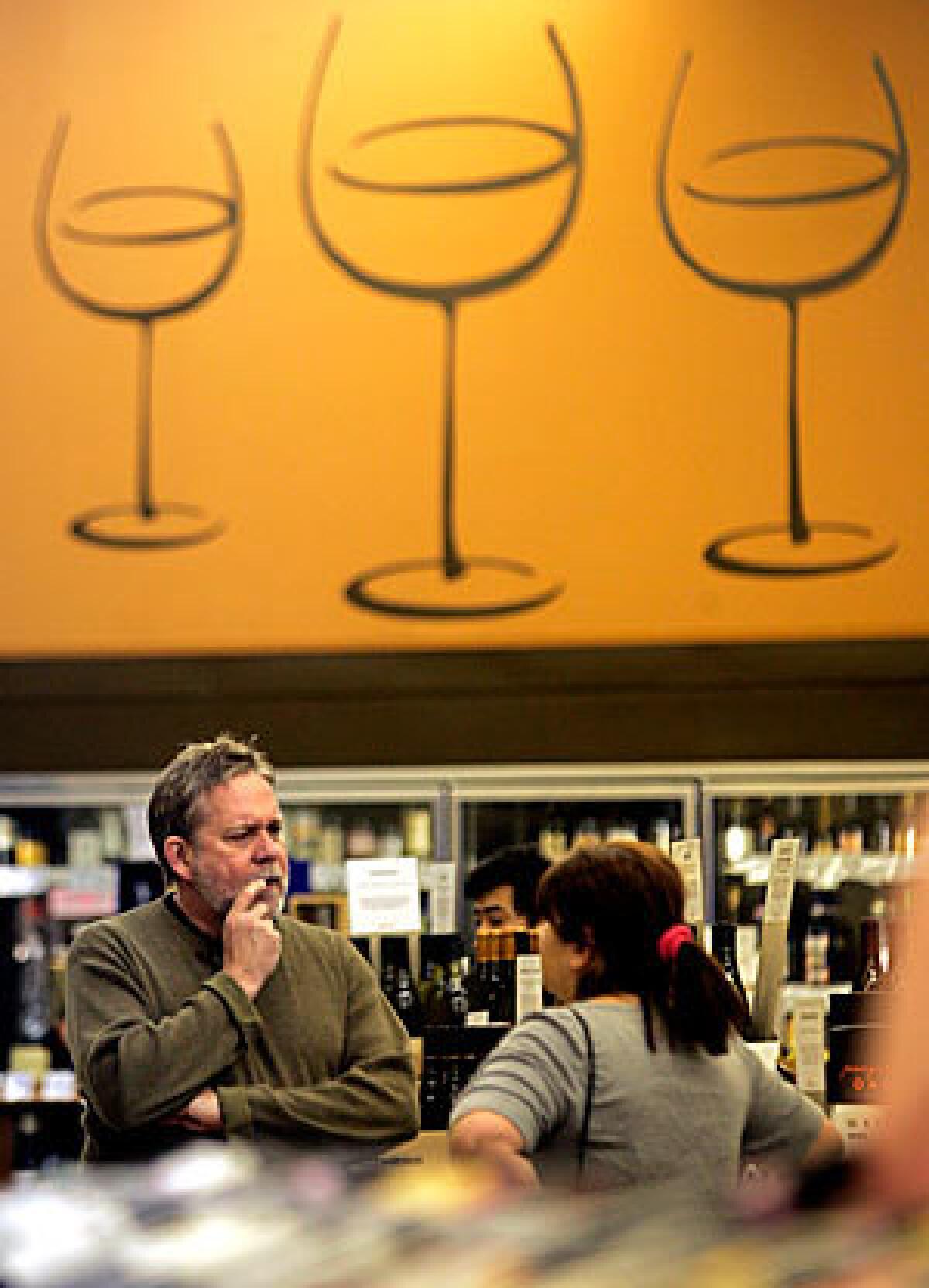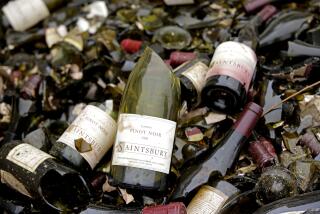It’s a buyer’s market in wine

As we limp into 2009, watching our mad money dwindle from a mountain to a mound to a modest lump, you’d probably rather not think too much about restocking the dent you put in your wine collection over the holidays.
But there are many signs that this economic downturn could result in a mini-boom for wine lovers. Perhaps more than at any other time in the last five years, this is an opportunity for consumers to not only drink really good wines, but also to drink better for less. This is true in nearly every price category, and in nearly every region; for the truly savvy, this could be one of the more exciting periods in recent years for America’s rekindled love affair with the grape.
All of the area retailers I spoke with said that, despite bouts of dark humor along the lines of “things are so bad I can’t stop drinking now,” all is not gloom and doom on the floors of your average wine shop. “People are pretty happy when they’re here,” says wine buyer Kyle Meyer of the Wine Exchange in Orange. “I mean, this isn’t a doctor’s office.”
Indeed, there’s a prevailing sense that, even in tough economic times, Americans have not lost their thirst for good wine, and its enjoyment has become a regular part of their lives. We all may be watching our pennies, but so far, at any rate, we haven’t been willing to part with this everyday pleasure. The genie is out of the bottle, and the only place it’s going to go is into a glass.
But the mood has turned less exuberant than it was in the rip-roaring days before the crash. “People are definitely trading down,” says Mike Greene, general manager of Woodland Hills Wine Co. “They don’t seem to be cutting back on the amount of wine they’re buying, but they’re much more fixated on what they’re spending.”
And retailers have responded. There’s consensus that 2009 will be the Year of the Shrinkage. In the coming months, distributors will be looking for every opportunity to trim their inventory.
The result is a buyer’s market for retailers and consumers alike. Wine shops are scouring distributor catalogs for bargains and actively recalibrating their stock for the new economic reality. In many parts of the market, deals are there for the taking.
“Oh yeah, we’re vultures, no question about it,” says Meyer of the Wine Exchange, “but we know good wine, and we’re giving our customers more for what they spend.”
New comfort zone
Most retailers agree that, in terms of a retail “sweet spot” -- the price that regular customers feel most comfortable spending -- $25 has become the new $40. Whether it’s a village Burgundy or a fancy new Syrah from Walla Walla, Wash., people are comfortable spending $25 but get balky if the price rises much above that. As for the more expensive wines? “If you’re a $40 wine on the shelf,” Woodland Hills’ Greene says, “you’re probably a pretty lonely bottle about now.”
That’s not to say that customers have abandoned expensive wine. “My customers still want their special bottles,” says Jim Knight from the Wine House in West L.A., who points out that his allocation of the pedigreed Santa Ynez Rhône blend from Jonata (as in the folks who bring you Screaming Eagle) was snatched up in days. “They still want their Friday-night dinner wine to be a step up from Wednesday’s.”
But even among highflying, Parker-point-chasing, mega-cult reds, there are deals. “If you don’t have a track record,” Greene says, “you may just have to suck it up and price it right.”
At least some of the deals are coming from distributors, whose warehouses are full of inventory accumulated in better days and who are striking deals to move it out. A store like Wine Exchange is large enough, and has sufficient clout among distributors, that Meyer can leverage even better margins above already discounted offers. “They’ll come to me with a 30% discount. I tell them, ‘You give me 50% and I’ll take it all.’ ” That’s the sort of bargain Meyer likes to pass on to his monthly wine clubs and other dedicated customers. Not every shop has this sort of leverage, but most stores have taken advantage of closeouts, end-of-vintage or end-of-year specials.
Some of the wines being offered by distributors are rarities, boutique and hard-to-find wines that in the past would have been allocated to just a tiny group of mostly restaurant accounts but now are going to a broader range of outlets. “We’ve really benefited from some allocation shifts,” says Chris Meeske of Mission Wines in South Pasadena, who can now get wines like the current vintage of Ridge’s great Cabernet blend, Monte Bello. “I’ve got all of these wines I couldn’t get before, and they’re flying out the door.” Some wineries are even cutting out the middleman; one retailer spoke of a winery owner who tried to sell him his wine direct at a price that undercut the winery’s distributor by 20%.
Good value
Going straight to the source can certainly pay off, even if you’re not allowed to say who that source might be. Late last year, Gary Fishman, domestic wine buyer for Wally’s Wine Merchant, purchased and bottled a 2006 Cabernet blend from a well-regarded, Parker-anointed Napa winery (which must remain nameless) as a store brand for the L.A. wine shop. Called Cyclone, it retails for about $70, less than half the price of similar wines from that winery.
Meanwhile, the new $25 sweet spot is crowded with value. After a string of good vintages in the Beaujolais, Loire and Rhône valleys, even the most modest bottlings from those regions are drinking beautifully. The 2007 vintage in the Piedmont will one day yield some exquisite Barolos and Barbarescos; but the inexpensive Nebbiolos from Alba and the Langhe -- not to mention a bumper crop of charming Dolcettos and Barberas -- are marvelous right now. In Spain, 2007 wasn’t quite the same quality vintage as in France and Italy, but the values from places like Montsant, Rueda and Bierzo are as strong as ever.
Every retailer I spoke with mentioned the exceptional Malbecs of Argentina, which continue to outperform for their price. Not only do they get better with each vintage, but they also stay inexpensive -- almost all of them are under $20.
And most retailers predicted that Australia’s crowded tier of premium Shirazes and other reds -- wines that came into the market at $40 or more -- is almost certainly going to be discounted for tremendous bargains.
You might expect smaller retail shops, such as Mission Wines in South Pasadena and the Colorado Wine Co. in Eagle Rock, to be more vulnerable to economic woes, but so far that hasn’t proven to be the case. They may not have the buying power of some of the bigger stores, but with a smaller inventory they can be more nimble with their stock.
And all are doing more with less. “Instead of having three Amarone, I’ve got one, and a much cheaper ripasso-style Valpolicella that drinks like one,” says John Nugent, owner of the Colorado Wine Co. The shelves are far from empty; they’re just filled with less-expensive, more carefully selected wine.
The care that goes into selection is certainly not lost on its clientele, which has a bond with the store that Nugent says has not diminished.
“I get people almost every day asking me how the shop is doing,” Nugent says. “They want to know we’re OK; they don’t want to lose the relationship. They don’t want to have to go to Vons for their dinner wine. They’re way past that.”
More to Read
Start your day right
Sign up for Essential California for news, features and recommendations from the L.A. Times and beyond in your inbox six days a week.
You may occasionally receive promotional content from the Los Angeles Times.






